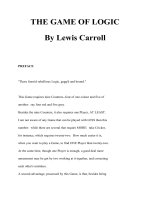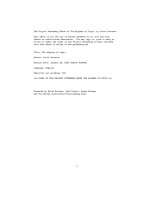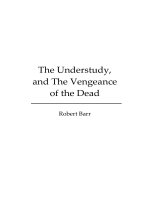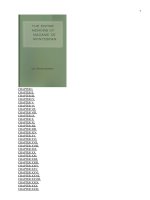THE GAME OF LOGIC By Lewis CarrollPREFACE doc
Bạn đang xem bản rút gọn của tài liệu. Xem và tải ngay bản đầy đủ của tài liệu tại đây (321.64 KB, 135 trang )
THE GAME OF LOGIC
By Lewis Carroll
PREFACE
"There foam'd rebellious Logic, gagg'd and bound."
This Game requires nine Counters four of one colour and five of
another: say four red and five grey.
Besides the nine Counters, it also requires one Player, AT LEAST.
I am not aware of any Game that can be played with LESS than this
number: while there are several that require MORE: take Cricket,
for instance, which requires twenty-two. How much easier it is,
when you want to play a Game, to find ONE Player than twenty-two.
At the same time, though one Player is enough, a good deal more
amusement may be got by two working at it together, and correcting
each other's mistakes.
A second advantage, possessed by this Game, is that, besides being
an endless source of amusement (the number of arguments, that may
be worked by it, being infinite), it will give the Players a little
instruction as well. But is there any great harm in THAT, so long
as you get plenty of amusement?
CONTENTS.
CHAPTER PAGE
I. NEW LAMPS FOR OLD.
1. Propositions . . . . . . . 1
2. Syllogisms . . . . . . . . 20
3. Fallacies . . . . . . . . 32
II. CROSS QUESTIONS.
1. Elementary . . . . . . . . 37
2. Half of Smaller Diagram. Propositions
to be represented . . . . . 40
3. Do. Symbols to be interpreted. . 42
4. Smaller Diagram. Propositions to be
represented . . . . . . . 44
5. Do. Symbols to be interpreted. . 46
6. Larger Diagram. Propositions to be
represented . . . . . . . 48
7. Both Diagrams to be employed . . 51
III. CROOKED ANSWERS.
1. Elementary . . . . . . . . 55
2. Half of Smaller Diagram. Propositions
represented . . . . . . . 59
3. Do. Symbols interpreted . . . 61
4. Smaller Diagram. Propositions represented. 62
5. Do. Symbols interpreted . . . 65
6. Larger Diagram. Propositions represented. 67
7. Both Diagrams employed . . . . 72
IV. HIT OR MISS . . . . . . . . . 85
CHAPTER I.
NEW LAMPS FOR OLD.
"Light come, light go."
_________
1. Propositions.
"Some new Cakes are nice."
"No new Cakes are nice."
"All new cakes are nice."
There are three 'PROPOSITIONS' for you the only three kinds we
are going to use in this Game: and the first thing to be done is
to learn how to express them on the Board.
Let us begin with
"Some new Cakes are nice."
But before doing so, a remark has to be made one that is rather
important, and by no means easy to understand all in a moment: so
please to read this VERY carefully.
The world contains many THINGS (such as "Buns", "Babies", "Beetles".
"Battledores". &c.); and these Things possess many ATTRIBUTES
(such as "baked", "beautiful", "black", "broken", &c.: in fact,
whatever can be "attributed to", that is "said to belong to", any
Thing, is an Attribute). Whenever we wish to mention a Thing, we
use a SUBSTANTIVE: when we wish to mention an Attribute, we use
an ADJECTIVE. People have asked the question "Can a Thing exist
without any Attributes belonging to it?" It is a very puzzling
question, and I'm not going to try to answer it: let us turn up
our noses, and treat it with contemptuous silence, as if it really
wasn't worth noticing. But, if they put it the other way, and ask
"Can an Attribute exist without any Thing for it to belong to?", we
may say at once "No: no more than a Baby could go a railway-journey
with no one to take care of it!" You never saw "beautiful" floating
about in the air, or littered about on the floor, without any Thing
to BE beautiful, now did you?
And now what am I driving at, in all this long rigmarole? It is
this. You may put "is" or "are" between names of two THINGS (for
example, "some Pigs are fat Animals"), or between the names of two
ATTRIBUTES (for example, "pink is light-red"), and in each case it
will make good sense. But, if you put "is" or "are" between the
name of a THING and the name of an ATTRIBUTE (for example, "some
Pigs are pink"), you do NOT make good sense (for how can a Thing
BE an Attribute?) unless you have an understanding with the person
to whom you are speaking. And the simplest understanding would, I
think, be this that the Substantive shall be supposed to be repeated
at the end of the sentence, so that the sentence, if written out
in full, would be "some Pigs are pink (Pigs)". And now the word
"are" makes quite good sense.
Thus, in order to make good sense of the Proposition "some new Cakes
are nice", we must suppose it to be written out in full, in the
form "some new Cakes are nice (Cakes)". Now this contains two
'TERMS' "new Cakes" being one of them, and "nice (Cakes)" the
other. "New Cakes," being the one we are talking about, is called
the 'SUBJECT' of the Proposition, and "nice (Cakes)" the 'PREDICATE'.
Also this Proposition is said to be a 'PARTICULAR' one, since it
does not speak of the WHOLE of its Subject, but only of a PART of
it. The other two kinds are said to be 'UNIVERSAL', because they
speak of the WHOLE of their Subjects the one denying niceness, and
the other asserting it, of the WHOLE class of "new Cakes". Lastly,
if you would like to have a definition of the word 'PROPOSITION'
itself, you may take this: "a sentence stating that some, or
none, or all, of the Things belonging to a certain class, called
its 'Subject', are also Things belonging to a certain other class,
called its 'Predicate'".
You will find these seven words PROPOSITION, ATTRIBUTE, TERM,
SUBJECT, PREDICATE, PARTICULAR, UNIVERSAL charmingly useful, if
any friend should happen to ask if you have ever studied Logic.
Mind you bring all seven words into your answer, and you friend
will go away deeply impressed 'a sadder and a wiser man'.
Now please to look at the smaller Diagram on the Board, and suppose
it to be a cupboard, intended for all the Cakes in the world (it
would have to be a good large one, of course). And let us suppose
all the new ones to be put into the upper half (marked 'x'), and all
the rest (that is, the NOT-new ones) into the lower half (marked
'x''). Thus the lower half would contain ELDERLY Cakes, AGED
Cakes, ANTE-DILUVIAN Cakes if there are any: I haven't seen many,
myself and so on. Let us also suppose all the nice Cakes to be
put into the left-hand half (marked 'y'), and all the rest (that
is, the not-nice ones) into the right-hand half (marked 'y''). At
present, then, we must understand x to mean "new", x' "not-new",
y "nice", and y' "not-nice."
And now what kind of Cakes would you expect to find in compartment
No. 5?
It is part of the upper half, you see; so that, if it has any Cakes
in it, they must be NEW: and it is part of the left-hand half;
so that they must be NICE. Hence if there are any Cakes in this
compartment, they must have the double 'ATTRIBUTE' "new and nice":
or, if we use letters, the must be "x y."
Observe that the letters x, y are written on two of the edges of
this compartment. This you will find a very convenient rule for
knowing what Attributes belong to the Things in any compartment.
Take No. 7, for instance. If there are any Cakes there, they must
be "x' y", that is, they must be "not-new and nice."
Now let us make another agreement that a red counter in a
compartment shall mean that it is 'OCCUPIED', that is, that there
are SOME Cakes in it. (The word 'some,' in Logic, means 'one or
more' so that a single Cake in a compartment would be quite enough
reason for saying "there are SOME Cakes here"). Also let us agree
that a grey counter in a compartment shall mean that it is 'EMPTY',
that is that there are NO Cakes in it. In the following Diagrams,
I shall put '1' (meaning 'one or more') where you are to put a RED
counter, and '0' (meaning 'none') where you are to put a GREY one.
As the Subject of our Proposition is to be "new Cakes", we are only
concerned, at present, with the UPPER half of the cupboard, where
all the Cakes have the attribute x, that is, "new."
Now, fixing our attention on this upper half, suppose we found it
marked like this,
| | |
| 1 | |
| | |
that is, with a red counter in No. 5. What would this tell us,
with regard to the class of "new Cakes"?
Would it not tell us that there are SOME of them in the x y-compartment?
That is, that some of them (besides having the Attribute x, which
belongs to both compartments) have the Attribute y (that is, "nice").
This we might express by saying "some x-Cakes are y-(Cakes)", or,
putting words instead of letters,
"Some new Cakes are nice (Cakes)",
or, in a shorter form,
"Some new Cakes are nice".
At last we have found out how to represent the first Proposition
of this Section. If you have not CLEARLY understood all I have
said, go no further, but read it over and over again, till you DO
understand it. After that is once mastered, you will find all the
rest quite easy.
It will save a little trouble, in doing the other Propositions,
if we agree to leave out the word "Cakes" altogether. I find it
convenient to call the whole class of Things, for which the cupboard
is intended, the 'UNIVERSE.' Thus we might have begun this business
by saying "Let us take a Universe of Cakes." (Sounds nice, doesn't
it?)
Of course any other Things would have done just as well as Cakes.
We might make Propositions about "a Universe of Lizards", or even
"a Universe of Hornets". (Wouldn't THAT be a charming Universe to
live in?)
So far, then, we have learned that
| | |
| 1 | |
| | |
means "some x and y," i.e. "some new are nice."
I think you will see without further explanation, that
| | |
| | 1 |
| | |
means "some x are y'," i.e. "some new are not-nice."
Now let us put a GREY counter into No. 5, and ask ourselves the
meaning of
| | |
| 0 | |
| | |
This tells us that the x y-compartment is EMPTY, which we may express
by "no x are y", or, "no new Cakes are nice". This is the second
of the three Propositions at the head of this Section.
In the same way,
| | |
| | 0 |
| | |
would mean "no x are y'," or, "no new Cakes are not-nice."
What would you make of this, I wonder?
| | |
| 1 | 1 |
| | |
I hope you will not have much trouble in making out that this
represents a DOUBLE Proposition: namely, "some x are y, AND some
are y'," i.e. "some new are nice, and some are not-nice."
The following is a little harder, perhaps:
| | |
| 0 | 0 |
| | |
This means "no x are y, AND none are y'," i.e. "no new are nice,
AND none are not-nice": which leads to the rather curious result
that "no new exist," i.e. "no Cakes are new." This is because
"nice" and "not-nice" make what we call an 'EXHAUSTIVE' division
of the class "new Cakes": i.e. between them, they EXHAUST the whole
class, so that all the new Cakes, that exist, must be found in one
or the other of them.
And now suppose you had to represent, with counters the contradictory
to "no Cakes are new", which would be "some Cakes are new", or,
putting letters for words, "some Cakes are x", how would you do
it?
This will puzzle you a little, I expect. Evidently you must put
a red counter SOMEWHERE in the x-half of the cupboard, since you
know there are SOME new Cakes. But you must not put it into the
LEFT-HAND compartment, since you do not know them to be NICE: nor
may you put it into the RIGHT-HAND one, since you do not know them
to be NOT-NICE.
What, then, are you to do? I think the best way out of the
difficulty is to place the red counter ON THE DIVISION-LINE between
the xy-compartment and the xy'-compartment. This I shall represent
(as I always put '1' where you are to put a red counter) by the
diagram
| | |
| -1- |
| | |
Our ingenious American cousins have invented a phrase to express
the position of a man who wants to join one or the other of two
parties such as their two parties 'Democrats' and 'Republicans' but
can't make up his mind WHICH. Such a man is said to be "sitting
on the fence." Now that is exactly the position of the red counter
you have just placed on the division-line. He likes the look of
No. 5, and he likes the look of No. 6, and he doesn't know WHICH to
jump down into. So there he sits astride, silly fellow, dangling
his legs, one on each side of the fence!
Now I am going to give you a much harder one to make out. What
does this mean?
| | |
| 1 | 0 |
| | |
This is clearly a DOUBLE Proposition. It tells us not only that
"some x are y," but also the "no x are NOT y." Hence the result
is "ALL x are y," i.e. "all new Cakes are nice", which is the last
of the three Propositions at the head of this Section.
We see, then, that the Universal Proposition
"All new Cakes are nice"
consists of TWO Propositions taken together, namely,
"Some new Cakes are nice,"
and "No new Cakes are not-nice."
In the same way
| | |
| 0 | 1 |
| | |
would mean "all x are y' ", that is,
"All new Cakes are not-nice."
Now what would you make of such a Proposition as "The Cake you have
given me is nice"? Is it Particular or Universal?
"Particular, of course," you readily reply. "One single Cake is
hardly worth calling 'some,' even."
No, my dear impulsive Reader, it is 'Universal'. Remember that,
few as they are (and I grant you they couldn't well be fewer),
they are (or rather 'it is') ALL that you have given me! Thus, if
(leaving 'red' out of the question) I divide my Universe of Cakes
into two classes the Cakes you have given me (to which I assign
the upper half of the cupboard), and those you HAVEN'T given me
(which are to go below) I find the lower half fairly full, and the
upper one as nearly as possible empty. And then, when I am told
to put an upright division into each half, keeping the NICE Cakes
to the left, and the NOT-NICE ones to the right, I begin by carefully
collecting ALL the Cakes you have given me (saying to myself, from
time to time, "Generous creature! How shall I ever repay such
kindness?"), and piling them up in the left-hand compartment. AND
IT DOESN'T TAKE LONG TO DO IT!
Here is another Universal Proposition for you. "Barzillai Beckalegg
is an honest man." That means "ALL the Barzillai Beckaleggs, that
I am now considering, are honest men." (You think I invented that
name, now don't you? But I didn't. It's on a carrier's cart,
somewhere down in Cornwall.)
This kind of Universal Proposition (where the Subject is a single
Thing) is called an 'INDIVIDUAL' Proposition.
Now let us take "NICE Cakes" as the Subject of Proposition: that
is, let us fix our thoughts on the LEFT-HAND half of the cupboard,
where all the Cakes have attribute y, that is, "nice."
Suppose we find it marked like this: | |
| 1 |
What would that tell us? | |
| |
| |
| |
I hope that it is not necessary, after explaining the HORIZONTAL
oblong so fully, to spend much time over the UPRIGHT one. I hope
you will see, for yourself, that this means "some y are x", that
is,
"Some nice Cakes are new."
"But," you will say, "we have had this case before. You put a red
counter into No. 5, and you told us it meant 'some new Cakes are
nice'; and NOW you tell us that it means 'some NICE Cakes are NEW'!
Can it mean BOTH?"
The question is a very thoughtful one, and does you GREAT credit,
dear Reader! It DOES mean both. If you choose to take x (that
is, "new Cakes") as your Subject, and to regard No. 5 as part of a
HORIZONTAL oblong, you may read it "some x are y", that is, "some
new Cakes are nice": but, if you choose to take y (that is, "nice
Cake") as your Subject, and to regard No. 5 as part of an UPRIGHT
oblong, THEN you may read it "some y are x", that is, "some nice
Cakes are new". They are merely two different ways of expressing
the very same truth.
Without more words, I will simply set down the other ways in which
this upright oblong might be marked, adding the meaning in each
case. By comparing them with the various cases of the horizontal
oblong, you will, I hope, be able to understand them clearly.
You will find it a good plan to examine yourself on this table,
by covering up first one column and then the other, and 'dodging
about', as the children say.
Also you will do well to write out for yourself two other tables one
for the LOWER half of the cupboard, and the other for its RIGHT-HAND
half.
And now I think we have said all we need to say about the smaller
Diagram, and may go on to the larger one.
_________________________________________________
|
Symbols. | Meanings.
_______________|_________________________________
|
| | |
| | | Some y are x';
| | | i.e. Some nice are not-new.
|
| | |
| 1 | |
| | |
|
|
|
| | | No y are x;
| 0 | | i.e. No nice are new.
| | |
| [Observe that this is merely another way of
| | | expressing "No new are nice."]
| | |
| | |
|
|
|
| | |
| | | No y are x';
| | | i.e. No nice are not-new.
|
| | |
| 0 | |
| | |
|
|
|
| | |
| 1 | | Some y are x, and some are x';
| | | i.e. Some nice are new, and some are
| not-new.
| | |
| 1 | |
| | |
|
|
|
| | |
| 0 | | No y are x, and none are x'; i.e. No y
| | | exist;
| i.e. No Cakes are nice.
| | |
| 0 | |
| | |
|
|
|
| | |
| 1 | | All y are x;
| | | i.e. All nice are new.
|
| | |
| 0 | |
| | |
|
|
|
| | |
| 0 | | All y are x';
| | | i.e. All nice are not-new.
|
| | |
| 1 | |
| | |
|
_______________|_________________________________
This may be taken to be a cupboard divided in the same way as the
last, but ALSO divided into two portions, for the Attribute m. Let
us give to m the meaning "wholesome": and let us suppose that all
WHOLESOME Cakes are placed INSIDE the central Square, and all the
UNWHOLESOME ones OUTSIDE it, that is, in one or other of the four
queer-shaped OUTER compartments.
We see that, just as, in the smaller Diagram, the Cakes in each
compartment had TWO Attributes, so, here, the Cakes in each compartment
have THREE Attributes: and, just as the letters, representing the
TWO Attributes, were written on the EDGES of the compartment, so,
here, they are written at the CORNERS. (Observe that m' is supposed
to be written at each of the four outer corners.) So that we can
tell in a moment, by looking at a compartment, what three Attributes
belong to the Things in it. For instance, take No. 12. Here we
find x, y', m, at the corners: so we know that the Cakes in it, if
there are any, have the triple Attribute, 'xy'm', that is, "new,
not-nice, and wholesome." Again, take No. 16. Here we find, at
the corners, x', y', m': so the Cakes in it are "not-new, not-nice,
and unwholesome." (Remarkably untempting Cakes!)
It would take far too long to go through all the Propositions,
containing x and y, x and m, and y and m which can be represented
on this diagram (there are ninety-six altogether, so I am sure you
will excuse me!) and I must content myself with doing two or three,
as specimens. You will do well to work out a lot more for yourself.
Taking the upper half by itself, so that our Subject is "new Cakes",
how are we to represent "no new Cakes are wholesome"?
This is, writing letters for words, "no x are m." Now this tells us
that none of the Cakes, belonging to the upper half of the cupboard,
are to be found INSIDE the central Square: that is, the two
compartments, No. 11 and No. 12, are EMPTY. And this, of course,
is represented by
| | |
| _____|_____ |
| | | | |
| | 0 | 0 | |
| | | | |
And now how are we to represent the contradictory Proposition "SOME x
are m"? This is a difficulty I have already considered. I think
the best way is to place a red counter ON THE DIVISION-LINE between
No. 11 and No. 12, and to understand this to mean that ONE of the
two compartments is 'occupied,' but that we do not at present know WHICH.
This I shall represent thus:
| | |
| _____|_____ |
| | | | |
| | -1- | |
| | | | |
Now let us express "all x are m."
This consists, we know, of TWO Propositions,
"Some x are m,"
and "No x are m'."
Let us express the negative part first. This tells us that none
of the Cakes, belonging to the upper half of the cupboard, are to
be found OUTSIDE the central Square: that is, the two compartments,
No. 9 and No. 10, are EMPTY. This, of course, is represented by
| 0 | 0 |
| _____|_____ |
| | | | |
| | | | |
| | | | |
But we have yet to represent "Some x are m." This tells us that
there are SOME Cakes in the oblong consisting of No. 11 and No.
12: so we place our red counter, as in the previous example, on









